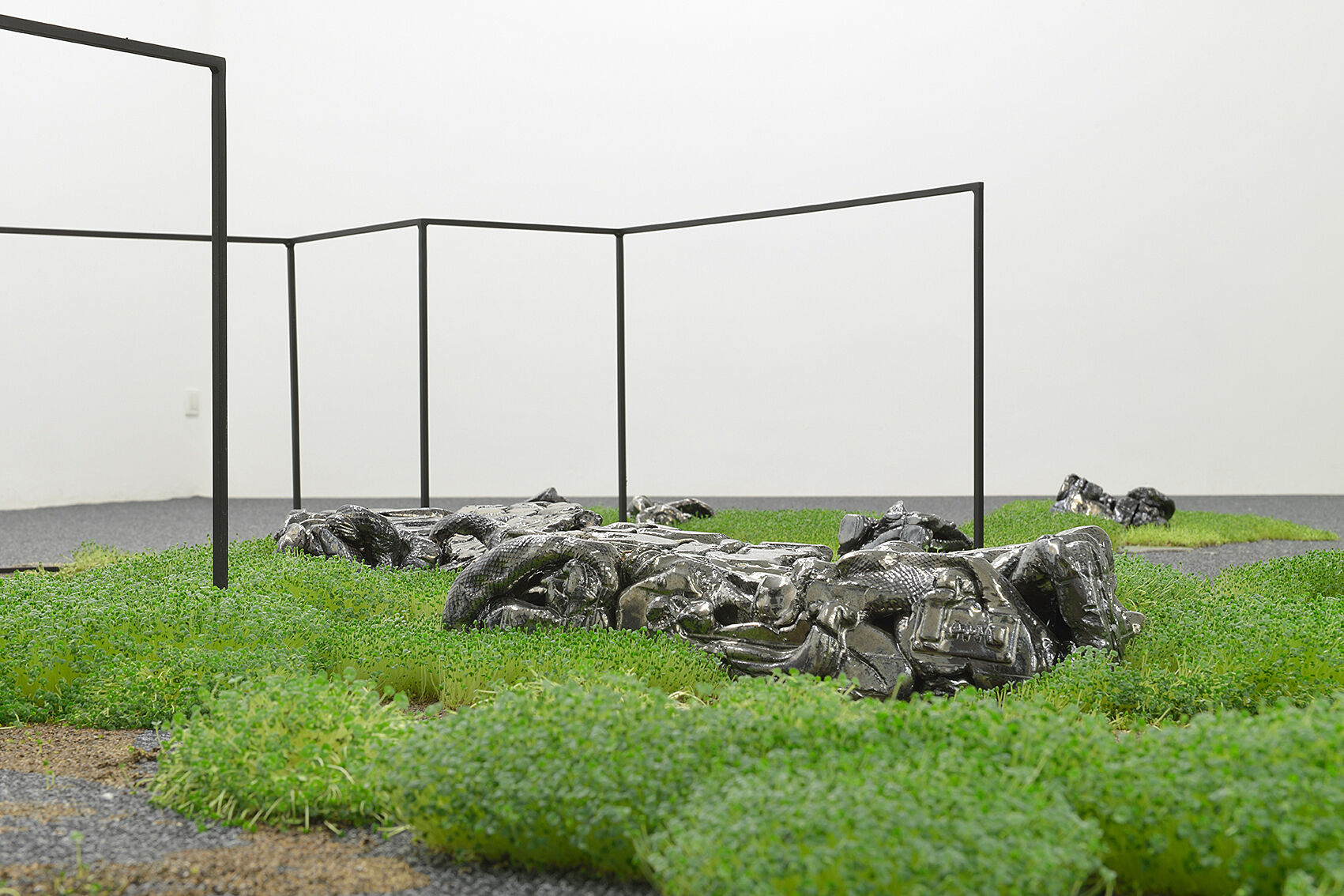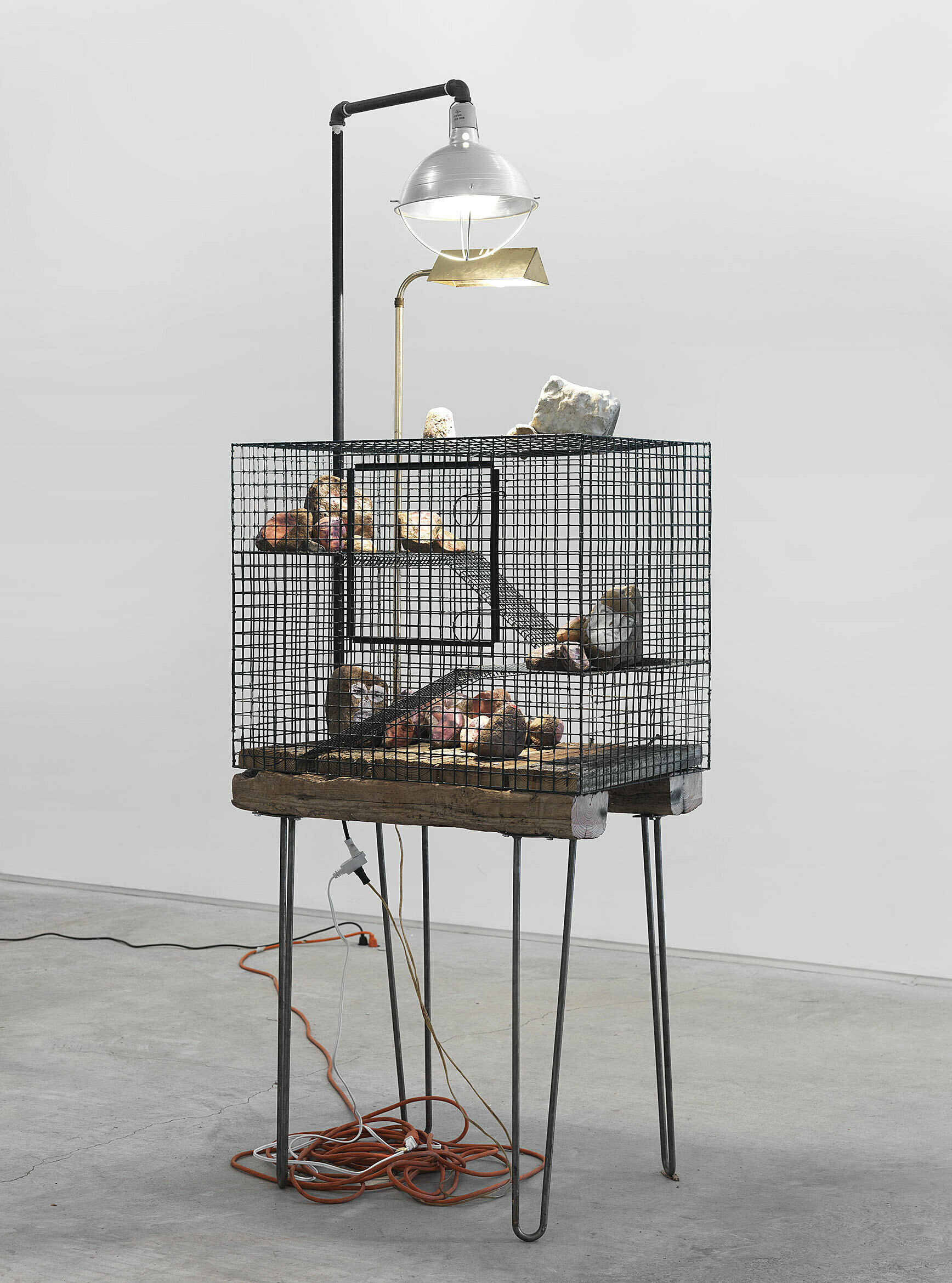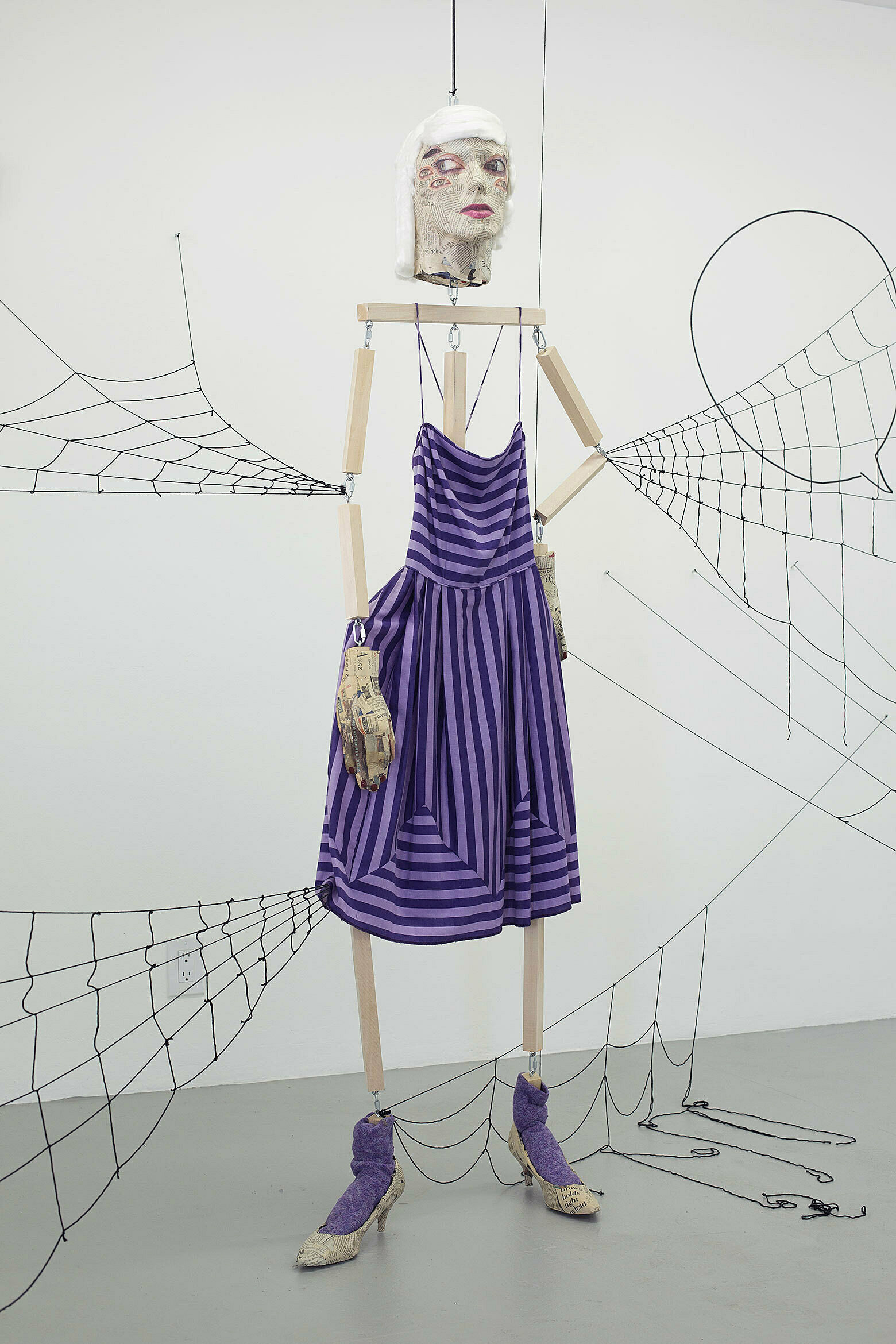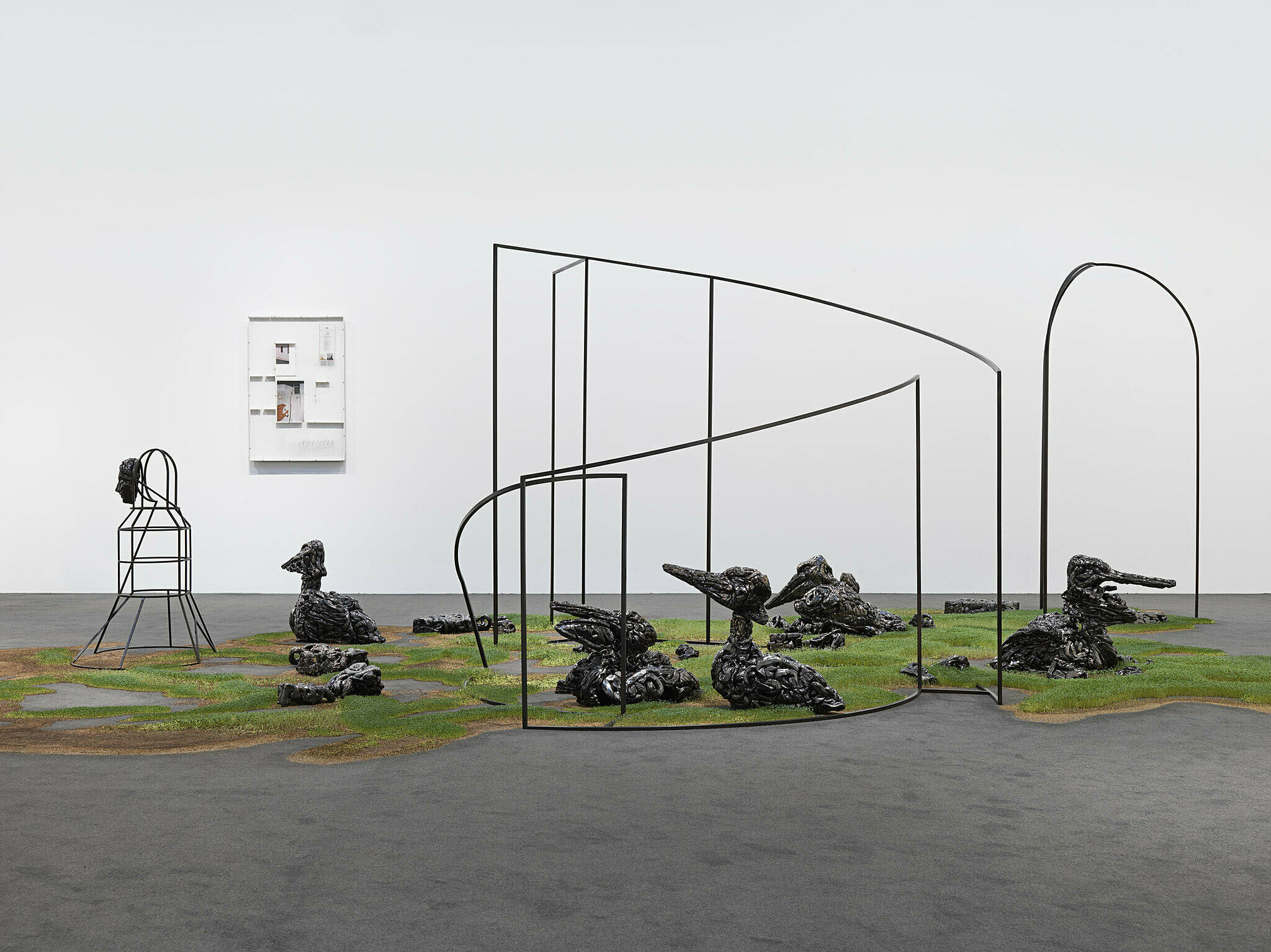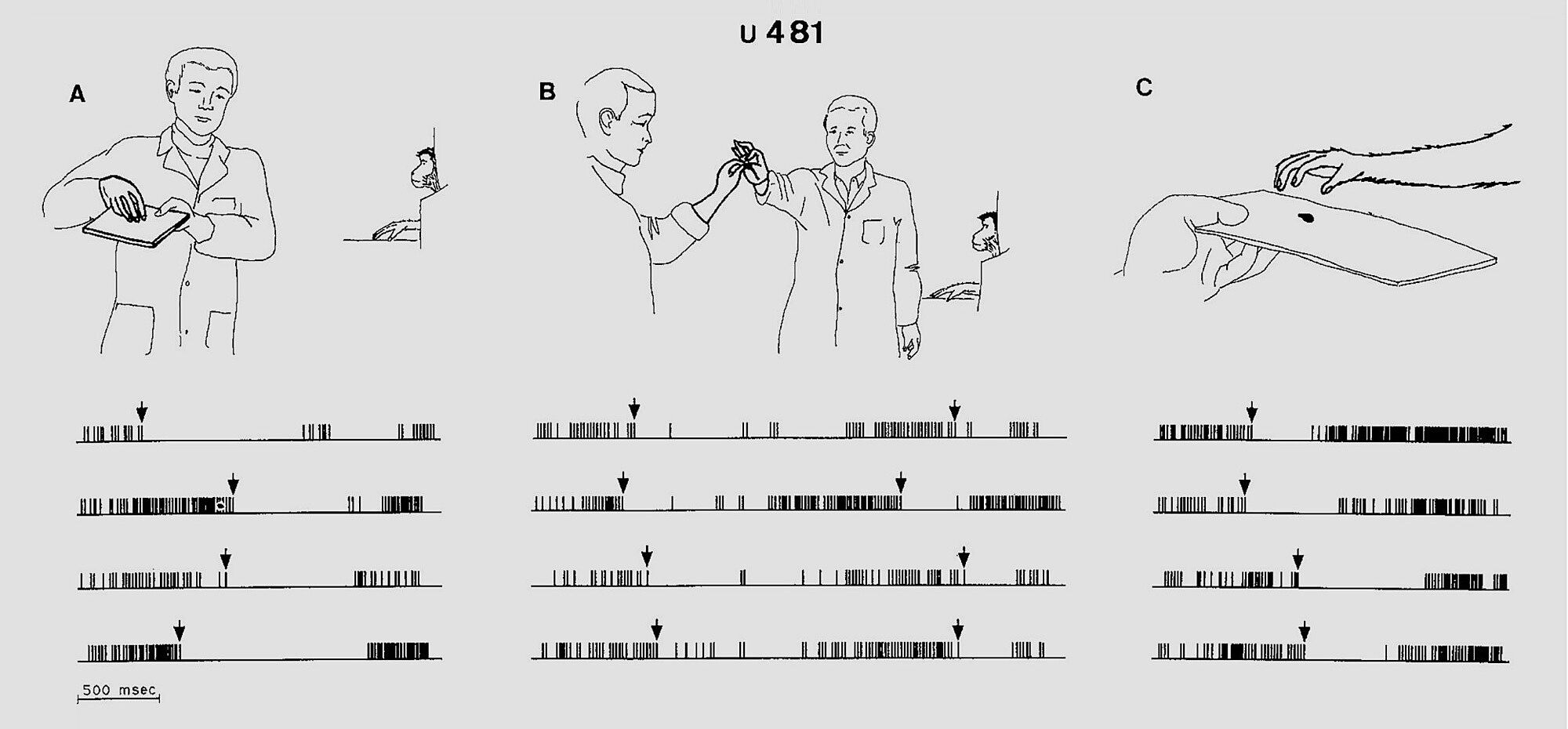Mirror Cells
Actual Things
Mirror Cells brings together five artists working in sculpture, unified through a similar use of content and narrative, a shared interest in materiality, and an emphasis on fabrication in a moment rife with high-production, depersonalized work. Collectively, the artists (Liz Craft, Rochelle Goldberg, Elizabeth Jaeger, Maggie Lee, and Win McCarthy) are each preoccupied with immediacy in their work—something they achieve by engaging with personal and political issues and by emphasizing materials. As a group, they acknowledge an overarching difficulty in being in the world today, whether due to personal traumas, the broader state of affairs, or even the expectations that come with the professionalization of artists. They reflect a world that requires empathy, which they provide through the objects they produce and their particular and distinctive vocabularies of materials and forms.
An interest in tactility plays an important role within their respective practices, confirming an active interest in shifting away from work that feels removed from its maker, and physically underscoring conceptual references to the personal. This impulse appears in contrast to much of the digitally based work that has become pervasive, which often relies on advanced technologies to realize ideas and concerns itself with broader issues surrounding digital culture.1 Such work sometimes suggests a passiveness emblematic of digital culture and our current obsession with this phenomenon. The works in Mirror Cells have a surreal quality, as in the odd array of female figures suspended from the ceiling and the imagined landscape, complete with living material and inanimate forms arrayed on the floor. The artists are committed to creating something otherworldly yet self-contained, sharing the spirit of Louise Bourgeois’s cells—works she made at the end of her long career that functioned as microcosms, fusing objects borrowed from the external world and the internal life of the artist, often connected to her personal traumas.2
When I visited Jaeger in her Bushwick, Brooklyn, studio last summer she showed me examples of her work, and we discussed books she was reading and using for research. She shared with me a publication she was particularly excited about—Sculpture and Touch—and we talked about her desire to engage emotionally with her work. The book, from a recent series titled Subject/Object: New Studies in Sculpture, focuses on integrating the study of sculpture into other disciplines and with other material contexts,3 an idea that fundamentally dovetails with this exhibition. Mirror Cells invokes the neuroscientific study of mirror neurons—specialized cells that react during observations or reenactments of the physical actions of others—and attempts to situate sculpture outside a strictly art historical conversation. Similarly, Sculpture and Touch considers the ways in which tactile contact can have a positive effect on our emotional and cognitive processes. And while it primarily touts the value viewers derive from touching aesthetic objects and experiencing sculpture physically, the benefit to artists in making the work (largely in their studios without the aid of assistants) seems a natural extension of the argument. The artists in Mirror Cells are united by an almost cathartic process in producing their work, in addition to a strong commitment to using modest materials and a willingness to convey a heightened emotional openness within the sculptures.
Jaeger’s practice routinely grapples with ideas and emotions embedded creatively within a familiar object, though the narrative is often incomplete or obscured. For her Whitney project—a series of strangely scaled ceramic vessels unusually mounted on metal sawhorses—the sculptures evoke human forms. Here the work becomes a meditation on the declining health of her grandfather, whose name serves as its title, as he slowly succumbs to dementia. “The intention of the work is to say things I cannot verbalize,” she explains. “He’s become a listing ship within his body and in the ocean of his mind—a boat with no destination."4 Her desire to visually represent the struggle of her grandfather’s decline—to marry narrative and form—is an essential and undeniable aspect of the work.
Lee’s film Mommy similarly exposes personal emotional trauma. The autobiographical film morphs into something almost fantastical as Lee acknowledges feeling desperate to “transmit each feeling."5 She uses found images and video, text, and drawings, as well as a variety of editing techniques and a powerful soundtrack, to visually articulate her lived experience, weaving surreal elements into her personal narrative. At times the work is jarring in its rawness, as when Lee learns of her mother’s sudden death from a brain aneurysm or suffers her own breakdown while emptying her mother’s home in New Jersey. The film’s surreal sensibility is heightened by its nonlinear story line— one that consistently incorporates a range of materials and unconventional editing techniques. Lee’s four sculptural installations on view similarly invoke specific family members—her mother, father, sister, and herself—and corresponding relationships. She embellishes the monitors with elements particular to each individual, creating living memories that simultaneously showcase teen culture and a strange, invented world rooted in Lee’s experiences.
For McCarthy, odd, seemingly impermanent sculptures—which he calls “maquettes” in reference to their preliminary, almost unfinished state, emphasizing their quick assembly—address his anxiety about his work and the city he inhabits. The pieces function as stand-alone representations of what McCarthy sees as the sheer difficulty of being in the world, explored through references to his own experience, ranging from a re-creation of the Manhattan skyline to the inclusion of enigmatic self-portraits, elements from past exhibitions, and newspaper clippings of recent events. The precarious nature of the sculptures—fragile to the point of seeming on the verge of collapse—and McCarthy’s particular selection of images and text confirm the artist’s desire to reference personal concerns against the broader backdrop of world events. “I’m interested in understanding the human experience and condition, continually coming back to questions and preoccupations with time, death, and reconciling who am I, who are all these people?” McCarthy explains, adding that he actively strives to make work that is “emotionally viable.”6
Goldberg’s work is less personally revealing, and her installation functions somewhat abstractly when seen as a whole. The work represents concerns about the environment through a sculptural topography—a landscape on the floor composed of living chia and ceramic forms in various states of change. The ephemerality of this living material contrasts with the solidity of the ceramic objects, highlighting Goldberg’s sense of ecological fragility. Her surreal, assembled landscape points to problematic environments at the brink of failure or dissolution—an unstable world in a moment of transformation. Goldberg aspires to literally forge a relationship between living and nonliving things, seeking the space where the “intersection of animate or inanimate becomes unclear.”7 Much like Jaeger and McCarthy—artists physically harnessing the materiality of their works to emphasize their larger conceptual goals—Goldberg is deliberate and consistent with her use of ceramic clay, a material that becomes solid and hard but nonetheless bears evidence of the artist’s touch. As she explains, “All the ceramic works have the markings of fingerprints to perform contact.”8
Craft’s sculptures initially read as the least tethered to personal experience: unusual, marionette-like spider-women interact with nonsensical word bubbles and sculptures of mouths, forming an otherworldly constellation that seems to foment anxious chatter. The installation appears to present a vague, problematic narrative that we are not allowed to fully access. Craft summons a dark, strangely feminine realm with disembodied body parts and suspended figures who are disconnected from the words they might wish to utter. (The word bubbles contain few words or comprehensible phrases; one is accordingly titled Bla,Bla,Bla.) She ensures this world will be unable to function effectively by filling it with “junk and general uselessness.”9 Just as McCarthy and Goldberg suggest worlds they foresee or fear coming apart, Craft underscores the precariousness of the spaces we inhabit by deliberately filling hers with fragile structures, delicate materials, and an inconclusive narrative.
The Whitney has an important tradition (rooted in the 1950s) of presenting sculpture-driven exhibitions, often suggesting the need for viewers to see sculptural works together and for the museum to acknowledge the medium as notably distinct from painting. In 1968, after nearly four decades of hosting both the Whitney Annuals and Biennials, the museum presented an exhibition of only sculpture: the first Whitney Sculpture Annual. The exhibition featured a broad range of work and was deliberately sweeping, showcasing works ranging from George Segal’s Laundromat to Richard Serra’s Slow Roll for Philip Glass, examples understood as and unified by representing a particular moment. It established that sculpture—the “lesser” artistic discipline—was a medium deserving of a discrete exhibition context. Sculpture now seemed fundamentally and freshly engaged with the larger questions of the time about art-making.
The very next year the Whitney mounted another survey show of sculpture, opting to move in a different and much more thematic direction. Organized by Marcia Tucker and James Monte, Anti-Illusion: Procedures/Materials had a simple and straightforward thesis that the curators firmly established in the accompanying catalogue: to present work that was “disordered.”10 Bringing together a group of artists who were working in what was soon to be labeled “process art,” the curators kept the focus on shared interests, not similar results.
For Monte and Tucker, the work in Anti-Illusion was deliberately selected but was by no means visually unified—it seemed to “slip around style.”11 Instead, the exhibition ran the gamut from Keith Sonnier’s light sculpture, installed on the wall, to Rafael Ferrer’s impermanent outdoor installation composed of leaves and ice, which disappeared over the run of the exhibition. Formal correspondences were eschewed for a constellation of works with shared impulses related to an emphasis on “process,” yielding an array of objects that might have felt randomly assembled if considered only visually. The curators referred to the show as “the expression of a radical disenchantment with the present role of art in society . . . a groping towards an expectant new form of creation.”12 Mirror Cells is similarly unified through shared concerns, as each artist incorporates narratives and actual things and experiences of the world, now transposed into their invented realms—a distinctive process reinforced through a sensitivity to and use of materials that ultimately informs the examples included in the exhibition.
Through the years, the Whitney has continued to organize large-scale exhibitions of sculpture, both sweeping surveys along the lines of the annual and more focused shows organized around specific theses, regularly underscoring its commitment to the medium and to facilitating public appreciation of it. As examples, in 1976 the Museum mounted the exhibition 200 Years of American Sculpture, organized again by Marcia Tucker with a group of other curators. This exhibition was a broad look at the medium, acknowledging its overlooked status while highlighting the Whitney’s long-standing commitment to the medium in its own right. In the following decade, Lisa Phillips organized the 1984 sculpture exhibition The Third Dimension: Sculpture of the New York School. The Museum continued to acknowledge that sculpture required consideration on its own terms, unique for the basicness of the work, existing as three-dimensional object actively occupying space and inevitably commenting on the world. The curators of The Third Dimension saw that it was important to “present the work as an entity independent of painting and subject to its own historical dialectic.”13 This sentiment recurs in Sculpture and Touch, the book Jaeger shared in her studio: “Sculpture is formed of a narrow and specific history, concerned with processes of making and informed by the ways in which human beings use objects to attempt to make sense of the surrounding world. A sculpture sits in space, pulling or pushing all that visually surrounds it for its own ends.”14
Like their historical predecessors, these works continue a conversation around the practice—and evolution—of making sculpture, as well as a series of empathetic responses to the world, reflecting both personal realities and external political and cultural issues. Sculpture becomes a uniquely powerful transmitter of these ideas through its objecthood, materiality, and direct reference to the world.
1. Here I am thinking about artists like Simon Denny, Zak Kitnick, or even Josh Kline. Similarly, the 2015 New Museum Triennial, Surround Audience, actively sought to engage a number of artists interested in taking advantage of or questioning the proliferation of these new technologies—and the digital—ranging from examples by the painter Avery Singer to the cross-disciplinary collective DIS.
2. Both McCarthy and Lee reference the idea of the “nightmare” in their work, or in discussions around it. McCarthy remarks about the work in the show: “In their inception, these works were supposed to be ‘nightmare versions’ of exhibitions I had done in the past.” Win McCarthy, email message to author, March 21, 2016.
3. Peter Dent, ed., Sculpture and Touch (Surrey, England: Ashgate Publishing Limited, 2014), xii.
4. Elizabeth Jaeger, email message to the author, March 2016.
5. Wendy Yao, “1000 Words: Maggie Lee,” Artforum 54, no. 8 (April 2016): 211.
6. McCarthy, email message to author, March 2016.
7. "Rochelle Goldberg interviewed by Elena Tavecchia," Mousse magazine, March 19, 2016.
8. Ibid.
9. Sculpture magazine online, 2004.
10. James Monte and Marcia Tucker, Anti-Illusion: Procedures/Materials (New York: Whitney Museum of American Art, 1969), 25.
11. Ibid, 13.
12. Whitney Museum of American Art press release, “'Anti-Illusion’ Exhibition at Whitney,” May 19, 1969.
13. Lisa Phillips, The Third Dimension: Sculpture of the New York School (New York: Whitney Museum of American Art, 1984), 10.
14. Dent, Sculpture and Touch, xii.

